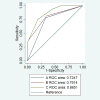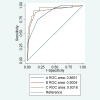Coronary Computed Tomography Angiography-Specific Definitions of High-Risk Plaque Features Improve Detection of Acute Coronary Syndrome
- PMID: 30354493
- PMCID: PMC6205220
- DOI: 10.1161/CIRCIMAGING.118.007657
Coronary Computed Tomography Angiography-Specific Definitions of High-Risk Plaque Features Improve Detection of Acute Coronary Syndrome
Abstract
Background High-risk plaque (HRP) features as detected by coronary computed tomography angiography (CTA) predict acute coronary syndrome (ACS). We sought to determine whether coronary CTA-specific definitions of HRP improve discrimination of patients with ACS as compared with definitions from intravascular ultrasound (IVUS). Methods and Results In patients with suspected ACS, randomized to coronary CTA in the ROMICAT II (Rule Out Myocardial Infarction/Ischemia Using Computer Assisted Tomography II) trial, we retrospectively performed semiautomated quantitative analysis of HRP (including remodeling index, plaque burden as derived by plaque area, low computed tomography attenuation plaque volume) and degree of luminal stenosis and analyzed the performance of traditional IVUS thresholds to detect ACS. Furthermore, we derived CTA-specific thresholds in patients with ACS to detect culprit lesions and applied those to all patients to calculate the discriminatory ability to detect ACS in comparison to IVUS thresholds. Of 472 patients, 255 patients (56±7.8 years; 63% men) had coronary plaque. In 32 patients (6.8%) with ACS, culprit plaques (n=35) differed from nonculprit plaques (n=172) with significantly greater values for all HRP features except minimal luminal area (significantly lower; all P<0.01). IVUS definitions showed good performance while minimal luminal area (odds ratio: 6.82; P=0.014) and plaque burden (odds ratio: 5.71; P=0.008) were independently associated with ACS but not remodeling index (odds ratio: 0.78; P=0.673). Optimized CTA-specific thresholds for plaque burden (area under the curve: 0.832 versus 0.676) and degree of stenosis (area under the curve: 0.826 versus 0.721) showed significantly higher diagnostic performance for ACS as compared with IVUS-based thresholds (all P<0.05) with borderline significance for minimal luminal area (area under the curve: 0.817 versus 0.742; P=0.066). Conclusions CTA-specific definitions of HRP features may improve the discrimination of patients with ACS as compared with IVUS-based definitions. CLINICAL TRIAL REGISTRATION URL: https://www.clinicaltrials.gov . Unique identifier: NCT01084239.
Keywords: acute coronary syndrome; angiography; computed tomography angiography; coronary angiography; myocardial ischemia; tomography, X-ray computed; ultrasonography, intravascular.
Figures




Comment in
-
Plaque Assessment Using Computed Tomography Angiography.Circ Cardiovasc Imaging. 2018 Aug;11(8):e008146. doi: 10.1161/CIRCIMAGING.118.008146. Circ Cardiovasc Imaging. 2018. PMID: 30354503 No abstract available.
Similar articles
-
hs-Troponin I Followed by CT Angiography Improves Acute Coronary Syndrome Risk Stratification Accuracy and Work-Up in Acute Chest Pain Patients: Results From ROMICAT II Trial.JACC Cardiovasc Imaging. 2015 Nov;8(11):1272-1281. doi: 10.1016/j.jcmg.2015.06.016. Epub 2015 Oct 14. JACC Cardiovasc Imaging. 2015. PMID: 26476506 Free PMC article. Clinical Trial.
-
Coronary CT angiography features of ruptured and high-risk atherosclerotic plaques: Correlation with intra-vascular ultrasound.J Cardiovasc Comput Tomogr. 2017 Nov;11(6):455-461. doi: 10.1016/j.jcct.2017.09.001. Epub 2017 Sep 5. J Cardiovasc Comput Tomogr. 2017. PMID: 28918858 Free PMC article.
-
Computed tomography-based high-risk coronary plaque score to predict acute coronary syndrome among patients with acute chest pain--Results from the ROMICAT II trial.J Cardiovasc Comput Tomogr. 2015 Nov-Dec;9(6):538-45. doi: 10.1016/j.jcct.2015.07.003. Epub 2015 Jul 10. J Cardiovasc Comput Tomogr. 2015. PMID: 26229036 Free PMC article. Clinical Trial.
-
Coronary CT angiography versus intravascular ultrasound for estimation of coronary stenosis and atherosclerotic plaque burden: a meta-analysis.J Cardiovasc Comput Tomogr. 2013 Jul-Aug;7(4):256-66. doi: 10.1016/j.jcct.2013.08.006. Epub 2013 Aug 23. J Cardiovasc Comput Tomogr. 2013. PMID: 24148779 Review.
-
Diagnostic Performance of Hybrid Cardiac Imaging Methods for Assessment of Obstructive Coronary Artery Disease Compared With Stand-Alone Coronary Computed Tomography Angiography: A Meta-Analysis.JACC Cardiovasc Imaging. 2018 Apr;11(4):589-599. doi: 10.1016/j.jcmg.2017.05.020. Epub 2017 Aug 16. JACC Cardiovasc Imaging. 2018. PMID: 28823745 Free PMC article.
Cited by
-
First in-human quantitative plaque characterization with ultra-high resolution coronary photon-counting CT angiography.Front Cardiovasc Med. 2022 Sep 6;9:981012. doi: 10.3389/fcvm.2022.981012. eCollection 2022. Front Cardiovasc Med. 2022. PMID: 36148053 Free PMC article.
-
Advanced CT measures of coronary artery disease with intermediate stenosis in patients with severe aortic valve stenosis.Eur Radiol. 2024 Aug;34(8):4897-4908. doi: 10.1007/s00330-023-10549-8. Epub 2024 Jan 8. Eur Radiol. 2024. PMID: 38189982 Free PMC article.
-
Non-obstructive high-risk plaques increase the risk of future culprit lesions comparable to obstructive plaques without high-risk features: the ICONIC study.Eur Heart J Cardiovasc Imaging. 2020 Sep 1;21(9):973-980. doi: 10.1093/ehjci/jeaa048. Eur Heart J Cardiovasc Imaging. 2020. PMID: 32535636 Free PMC article.
-
High-Risk Plaque Characteristics in Patients with Suspected Stable Coronary Artery Disease and Impaired Glucose Tolerance: A Coronary Computed Tomography Angiography Study.J Cardiovasc Dev Dis. 2025 Jan 22;12(2):37. doi: 10.3390/jcdd12020037. J Cardiovasc Dev Dis. 2025. PMID: 39997471 Free PMC article.
-
High-risk coronary plaque of sudden cardiac death victims: postmortem CT angiographic features and histopathologic findings.Int J Legal Med. 2024 Sep;138(5):1845-1856. doi: 10.1007/s00414-024-03228-w. Epub 2024 Apr 10. Int J Legal Med. 2024. PMID: 38594500 Free PMC article.
References
-
- Motoyama S, Sarai M, Harigaya H, Anno H, Inoue K, Hara T, Naruse H, Ishii J, Hishida H, Wong ND, Virmani R, Kondo T, Ozaki Y, Narula J. Computed tomographic angiography characteristics of atherosclerotic plaques subsequently resulting in acute coronary syndrome. J Am Coll Cardiol. 2009;54:49–57. - PubMed
-
- Hoffmann U, Moselewski F, Nieman K, Jang IK, Ferencik M, Rahman AM, Cury RC, Abbara S, Joneidi-Jafari H, Achenbach S, Brady TJ. Noninvasive assessment of plaque morphology and composition in culprit and stable lesions in acute coronary syndrome and stable lesions in stable angina by multidetector computed tomography. J Am Coll Cardiol. 2006;47:1655–62. - PubMed
-
- Puchner SB, Liu T, Mayrhofer T, Truong QA, Lee H, Fleg JL, Nagurney JT, Udelson JE, Hoffmann U, Ferencik M. High-risk plaque detected on coronary CT angiography predicts acute coronary syndromes independent of significant stenosis in acute chest pain: results from the ROMICAT-II trial. J Am Coll Cardiol. 2014;64:684–92. - PMC - PubMed
-
- Pflederer T, Marwan M, Schepis T, Ropers D, Seltmann M, Muschiol G, Daniel WG, Achenbach S. Characterization of culprit lesions in acute coronary syndromes using coronary dual-source CT angiography. Atherosclerosis. 2010;211:437–44. - PubMed
-
- Maurovich-Horvat P, Ferencik M, Voros S, Merkely B, Hoffmann U. Comprehensive plaque assessment by coronary CT angiography. Nat Rev Cardiol. 2014;11:390–402. - PubMed
Publication types
MeSH terms
Associated data
Grants and funding
LinkOut - more resources
Full Text Sources
Medical

